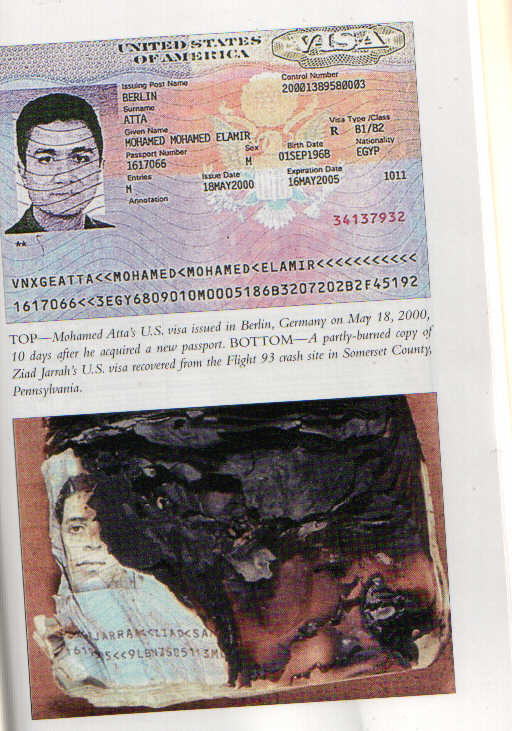Lebanese student pilot Ziad Jarrah, according to the National Commission on Terrorist Attacks Upon the United States, also known as the "911 Commission," was said to have been the pilot of the United Airlines Boeing 757-200 that crashed into the ground near Shanksville, Pennsylvania on the morning of September 11, 2001.
WMR has previously reported that based on numerous sources within the National Security Agency, Defense Intelligence Agency, and the U.S. Air Force, United 93 was shot down by the Air Force over Pennsylvania by two F-16s. A Global Hawk unmanned aerial vehicle was also in the vicinity of the doomed Boeing 757 and crashed where the large passenger plane was reported to have crashed.
In a compendium to the 9/11 Commission report titled, "Terrorist Travel," which contains travel documents allegedly used by the hijackers, a photograph of the U.S. visa of Ziad Jarreh is shown. The visa is said to have survived the crash of the Boeing 757 but miraculously, the fireball from the exploding aircraft managed to save that part of the visa that shows Jarrah's head shot photograph and part of his visa number.
Jarrah was born in Lebanon to Sunni Muslim parents but volunteered much of his time working with disabled and orphaned children at a Catholic school and church. There has been much speculation about whether Jarrah was ever a member of Mohamed Atta's "Hamburg cell" and whether he even boarded United flight 93 on 9/11. His background was remarkably secular.
However, based on videos of questionable origin and the visa from the crash site in Pennsylvania, spared from total obliteration by what can only be described as an "intelligent fire," is all the FBI had to conclude that Jarrah was the hijack team pilot of Flight 93. German authorities never obtained any evidence linking Jarrah to the Hamburg cell of Atta and the other accused hijackers.

Atta's visa (above) and Ziad Jarrah (below). The fire from the explosion of United 93 apparently "stopped on a dime" and left Jarrah's photo and U.S. visa number largely intact, largely proving to the FBI that he was the pilot of the hijacked airliner. All that. of course, if the 9/11 Commission is to be believed. Six out of the nine members of the commission believe that they were lied to and sandbagged by the Bush administration and top government officials. Click here for enlargement.
The following is excerpted from the 9/11 Commission report on the hijackers' travel documents:
May 25 [2000] -- Ziad Jarrah, a native of Lebanon, applied for and received a five-year B-1/B-2 (tourist/business) visa in Berlin. The consular officer who issued the visa could not recall whether he interviewed Jarrah. However, our review of Berlin visa policy for third-country nationals suggests that Jarrah was a strong visa candidate, given his long residence in Germany (approximately four years), academic involvement in Germany (at two universities), and Lebanese nationality. Third-country nationals with more than two0 years of residency in Germany met a threshold for visa approval. The officer who adjudicated his visa has stated that wealthy Lebanese families often send their children to school in Germany as a way to keep them out of the Middle East turmoil, and that Jarrah looked like one of those wealthy expatriates."
Not only was Jarrah a model visa candidate in the eyes of the Berlin consular officer but the visa issued would have a charmed existence, surviving a fiery plane crash to reveal Jarrah's photo and visa number.
And not only did the Berlin consular officer have a faulty memory in his interview of Jarreh but the Lebanese national's visa application was destroyed by the State Department along with those of other hijackers. From page 45 of the 9/11 travel document compendium:
"Of the 23 hijacker visa applications, five were destroyed routinely along with other documents before 9/11 and before their significance was known. The visa applications of Nawaz al Hazmi, Kahlid al Mihdhar (in 1999), Mohamed Atta, Marwan al Shehhi, and Ziad Jarrah were destroyed."
The report does not state what "other documents" were destroyed by the State Department prior to 9/11. Nor does the report explain why it was "routine" to destroy visa applications for visitors who were still in the United States.
The report does state that Jarrah's electronic record of Jarrah's visa application still existed at the State Department, along with his photo. Of course, electronic records are easily manipulated. The report states: "DOS record, NIV Applicant Detail of Ziad Jarrah, Nov. 8, 2001. Jarrah's original visa application was destroyed, but an electronic record, including his photograph, remains in the State Department's electronic records. A partly-burned copy of Jarrah's U.S. visa, recovered from the crash scene of Flight 93, is attached in Appendix A."
The report states that a "burned copy" of Jarrah's visa was found at the crash scene. However, such a visa would have been the original visa and attached to a page in Jarrah's Lebanese passport. The photo clearly shows what appears to be other passport pages behind the original visa.
There is an interesting footnote to the strange saga of Ziad Jarrah. Last year, two Lebanese brothers -- Ali Jarrah and Youssef Jarrah -- were arrested by Lebanese authorities who linked the pair to an espionage cell responsible for the car bombing assassination of Hezbollah military commander Imad Mughniyeh in Damascus in February 2008. The Jarrah's were found by the Lebanese Army in possession of "communication devices and other sophisticated equipment."
The Jarrahs arrested by the Lebanese had been recruited by the Mossad in the 1980s when Israel occupied a large section of Lebanon. And for a Paul Harvey-like "rest of the story," they are related to Ziad Jarreh, the man who was said to have been a close associate and fellow hijacking planner of Mohamed Atta and whose American visa was found with photo and visa number largely intact in a field in Pennsylvania on 9/11.
